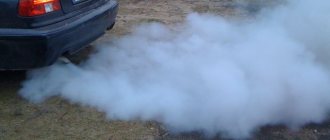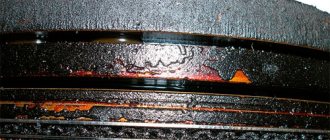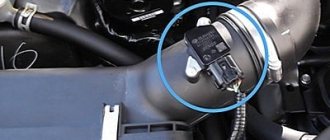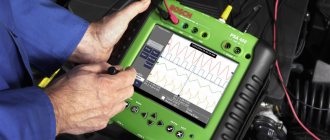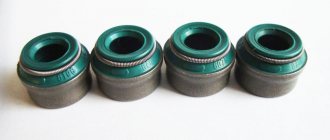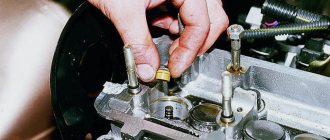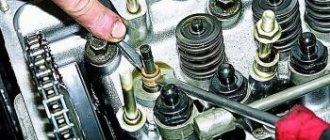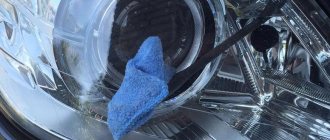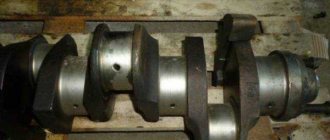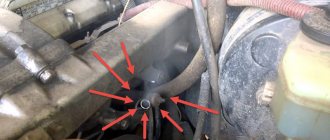Why is oil intensively consumed?
In a working engine, valve stem seals and rings are responsible for removing residual lubricant from the valve stem and cylinder walls, respectively.
At high speeds, the performance of this process decreases, but in general, oil consumption does not exceed the norm prescribed by the manufacturer. For some it is 1 l/10,000 km, for others it is 0.3 l/10,000 km, and still others may not add anything at all between service intervals, since they do not turn the engine above 3,500 rpm. Naturally, when lubricant consumption suddenly increases, say, to 1 l/1,000 km, and even blue smoke comes out of the exhaust, this is a signal of a violation of the oil scraper functions. There are several reasons for this:
- The oil scraper rings are stuck.
- The caps have become stiff.
- The valve guides are worn out.
As a result, it would be nice to determine without disassembly which particular group of parts failed. Whether this is possible is the topic of the next paragraph.
How valve seals work
Over time, valve seals dry out, causing engine oil to leak, forcing you to top it up more often.
Valve seals, as they are popularly called, are installed directly on the valve stems and are a combination of a rubber cage and a steel bushing designed to increase structural rigidity. When the valve opens, the cap closes it, preventing oil from flowing into the cylinder. Of course, a certain part of the lubricant still gets under the seal, but this is the norm - the unit is naturally lubricated. Over time, the elasticity of the part decreases, it dries out, and an increase in the volume of leaking liquid is observed. As a result, the oil “leaves”, forcing you to top it up to normal more and more often.
Valve seals or rings: how to determine what caused the blue smoke
If you've done a quick study of the issue, you've probably noticed that there is a lot of conflicting information. For example, there is a lot of controversy around the same compression: some argue that with normal pressure in the cylinders there is no reason to go into the piston, others insist that this is not an indicator at all in the current situation. And regarding the relationship between the engine temperature, the position of the gas pedal and the time of appearance of bluish smoke, it is not at all clear what’s what.
Let us immediately note that there is no connection between compression and defective oil scraper rings. Firstly, the rings that scrape oil from the cylinders wear out or become stuck first, while the compression rings continue to work as expected. Secondly, even with slightly worn compression rings and damaged oil scraper rings, compression will be normal, since the oil remains on the cylinder walls.
At the same time, unspoken differences exist that make it possible to determine what exactly has failed: caps or oil scraper rings. The difference is that each group of parts produces blue smoke at different intervals.
Symptoms of problems with caps
In the old days, stiff or worn valve seals were indicated by a puff of bluish smoke that burst out of the exhaust pipe immediately after starting the engine. By the way, these observations have not lost their relevance today. Even in this situation, it would be a good idea to ask how much the work costs and what else needs to be changed when replacing the valve stem seals on the engine.
The following test will help you accurately judge the caps for replacement:
- Warm up the engine to operating temperature.
- Let the engine run for 5-7 minutes while warm.
- Sharply depress the gas pedal for 5-10 seconds and watch the exhaust gases at this moment.
If there are problems with the seals, in the first seconds of the “gas to the floor” mode, a cloud of smoke with a bright bluish tint flies out of the muffler. For extra confidence, repeat the attempt to throttle to failure 2-3 more times. Observations are such that in subsequent cycles the puff of smoke will lose saturation, and may even disappear altogether.
For your information. The most reliable diagnosis is considered to be based on the color of the exhaust, in which “gas to the floor” is given after warming up and running the engine at operating temperature for 5-7 minutes. The bluish tint under such conditions turns out to be much more saturated than during the morning start and other gas conditions.
What explains this prioritization? If the cap is worn, oil will flow down the valve stem when the engine is running. Whether it will accumulate on the valve plate or immediately enter the cylinders is determined by the angle of the throttle valve. So, at idle, the speed of the air mass is low, the oil is not removed from the plate, but continues to accumulate. As soon as you sharply (it is important to press this way) press the gas pedal, air or the fuel-air mixture (depending on the type of fuel injection) draws the accumulated oil emulsion into the cylinders and it burns, forming a bluish smoke.
There will be no ominous tint at revs, and, in fact, there shouldn’t be. The oil does not have time to accumulate, but immediately enters the cylinders and burns in small fractions, which is why it does not affect the color of the exhaust gases.
It is worth noting that with a new catalyst, the color of the exhaust may not change at all, since it qualitatively converts CH into water vapor. On a half-dead catalytic converter or installed flame arrester, the picture appears in all its glory: there is smoke.
How to determine whether oil rings are faulty
Worn rings make themselves felt when under load. In reality, it looks like this: the color of the exhaust gases changes when moving uphill with the gas pedal half-pressed. It is worth noting that looking in the rearview mirror, you are unlikely to draw the right conclusion. The puff of smoke usually dissipates quickly. However, the driver of the car behind may well record his appearance.
For your information. There is an opinion that the initial stage of wear should be determined during gear shifting. If bluish smoke appears at this moment, the rings will need to be replaced soon.
When the rings are worn critically, smoke comes out constantly while driving and regardless of the terrain under the wheels. In addition, an increase in smoke is observed with increasing speed.
What else could cause a bluish-colored exhaust?
A defective turbine and faulty crankcase ventilation can also cause smoke. What distinguishes these failures from current caps or oil rings is the nature of the smoke: there is a lot of smoke + it can appear and disappear at any time. For example, the engine runs smoothly at idle and suddenly starts smoking, and after 3-4 minutes it stops.
A few tips will help you figure out what's going on:
- The turbine “drives” oil into the exhaust pipe. Smoke appears only after the exhaust tract has warmed up. There may be an oil leak at the joints of the exhaust system parts.
- Crankcase ventilation does not separate the oil from the air mixture. The oil separator is clogged as a result of using low-quality engine lubricant. The intake manifold is covered in streaks of oil emulsion, and clearly behind the ventilation hole.
Parting recommendations
If diagnostic results are unsatisfactory, experienced owners usually act by elimination. First, an attempt is made to decarbonize the oil scraper rings. If this is your first time encountering this concept, we recommend reading about what decarbonization is and why the engine needs it, as well as about the technology for decaburning piston rings using dimexide, as one of the inexpensive and effective means.
If an attempt to remove coke does not bring results, then work is planned on the cylinder head. If replacing the valve stem seals is unsuccessful, then a “overhaul” is performed.
Sooner or later, the car owner will be faced with the question of why the engine smokes, how to understand whether it is the rings or caps. For new cars, this question arises in the foreseeable future, but for older cars, the appearance of smoke from the exhaust pipe can be expected at any moment. There are many different reasons for its appearance, some of them are not even related to the technical condition of the engine. There are also several ways to get rid of this phenomenon.
The engine is smoking, how to understand it is the rings or caps at first glance is difficult, and for many drivers it seems impossible without completely disassembling it. In this article we will try to show that this is doable even in a garage. No special equipment is required; a compression gauge will be sufficient to diagnose the condition of the engine piston group.
Features of replacing caps on a 16-valve VAZ Priora
To gain access to the caps on the Priora, you will first have to unscrew the spark plugs from the wells, remove the ignition coils, and also remove the throttle assembly. After this, you can unscrew the valve cover bolts to remove the rocker arms and actually replace the MSC using a puller. In general, the situation is the same as in the case of the Lancer: TDC is set in the cylinders, crackers and springs are removed, new seals are installed, and reassembly is underway. As a rule, the entire complex of work takes the performer from 8 to 12 hours.
Why does smoke appear from the exhaust pipe?
To understand the reasons for the appearance of such a problem, you need to plunge a little into the principle of operation of the internal combustion engine, remember what processes occur in it. To ignite a flammable mixture, it must be compressed. This is done in the cylinders by a piston on which piston rings are installed for sealing. Friction occurs between the piston, rings and cylinder walls. To reduce wear of rubbing parts, engine oil is supplied to their working area. Wear of the oil scraper ring is the culprit for oil entering the combustion chamber.
The second way engine oil can enter the combustion chamber is through the gap between the valve and the guide sleeve.
To prevent oil from entering the fuel combustion zone, the valve stem and guide bushing are sealed using valve stem seals. When the material from which the valve seals are made loses its elasticity, oil enters the cylinder. But it also happens that both malfunctions coincide; engine oil penetrates into the cylinder through worn rings and through hard valve stem seals.
What is a valve seal?
Valve seals (or valve seals) are designed to prevent excess oil from leaking from the engine. Like most parts in the engine, they are made of rubber of a special composition. Time passes, these parts age, which means they lose their effectiveness. This is characterized by delamination. Old oil seals do not retain excess oil well, and lubricant consumption increases significantly. In addition to the high consumption of lubricant, this can greatly harm the engine. Let's look at the signs of failure of these parts, and also find out how to replace the valve stem seals.
Diagnostic methods
You can determine what happened to the motor instrumentally and as a result of observing the operation of the motor. Let's talk about this. You need to pay attention to the condition of the engine without waiting for abundant smoke to appear from the exhaust pipe. It’s time to sound the alarm when a sharp decrease in its level without visible leaks is noticed.
When traveling by car, observe the behavior of your car's engine in the rearview mirror; this can tell the owner a lot about its condition. If, after braking the engine, you sharply press the gas pedal and at that moment a ball of bluish smoke comes out of the muffler, this is a sure sign of wear on the valve stem seals. The same effect will occur when the engine is started after the car has been parked for a long time. This is explained by the penetration of oil located in the cylinder head through the gap between the valve stem and the guide sleeve into the combustion chamber.
The engine behaves somewhat differently when the piston rings wear out or become coked. In this case, smoke appears when the engine is running under load, when driving uphill, when overtaking and suddenly accelerating, leaving an unpleasant smoke trail behind the car. Indirect indicators of piston ring wear can be loss of engine power, difficult starting and increased fuel consumption.
The condition of the spark plugs can indicate such problems. Unscrew the spark plugs and inspect them carefully; their appearance can tell the driver a lot. If the working area of the spark plug is black, this is a sure sign of wear on the piston rings. Excess oil on the cylinder walls burns and partially remains in the form of carbon deposits on the piston head, valve plates and spark plugs. Cleaning the spark plugs from carbon will help, but only for a short time, since in this case the engine needs the help of mechanics.
Signs of wear on valve stem seals: how much oil does a 1.8 engine take?
The first and main symptom of hardened, worn valve seals is excessive consumption of engine oil. True, for some engines the regulations allow noticeable deviations from the generally accepted norm of 200-300 ml per 1000 km. Thus, 1.8 turbocharged engines installed on models of the Volkswagen AG automaker (Volkswagen, Audi, Skoda, Seat) legally require adding lubricant to 500-700 ml per thousand kilometers. A similar situation arises around PSA Peugeot Citroën engines, developed jointly with BMW (also installed on Mini models) - the passport data indicates a “norm” of 1000 ml of engine oil, which must be added to the engine every 1000 km.
Things like this highlight the importance of knowing your oil consumption. If the power unit consumes significantly more than the recommended values between service operations, then this is a serious reason to think about replacing the valve stem seals.
The second sign of oil leaving the cylinders due to the caps losing their condition is bluish-gray smoke from the exhaust pipe, which can be clearly seen in the first minutes of engine operation and then when changing gears, while pressing on the accelerator pedal. Also eloquent evidence of the above problem is oil deposits on the threaded part of the spark plug. When pressure increases in the combustion chamber, the mixture supersaturated with oil is partially squeezed out through microscopic gaps. For example, through the thread of a candle, where the gap is no more than 0.3 mm. Under the influence of high temperature, gasoline evaporates from the mixture, leaving behind a significant “reserve” of lubricant. Indirectly indicates the end of the caps and dark deposits on the electrodes.
Exactly the same soot appears on the cylinder walls. And if you ignore the problem, then one day the valve will simply burn due to plaque.
Video tips for checking the presence of oil burner
Instrumental check
A few words need to be said about how the technical condition of the engine is checked using instruments. To do this, you need to have a device called a compression meter. It doesn’t make sense to purchase it just for checking the engine, but we can say with great confidence that someone in the garage cooperative will have it. We can also say with great confidence that checking with its help gives the correct answer about the condition of the motor.
The compression test should only be carried out with the engine warmed up to operating temperature. You need to remove the spark plugs from the cylinder head, put the car on the handbrake and the gear shift lever in neutral. Next, forcefully insert the head of the compression gauge into the spark plug socket. After this, independently or with the help of an assistant, crank the engine crankshaft for a few seconds with the starter. The device will show the compression in this cylinder.
If its value is low, it is recommended to check again, but before doing so, pour 20-30 grams of engine oil into the cylinder. An increase in the compression value after this will confirm the wear of the piston rings. Coking of the piston rings can also help reduce compression. You can fight this, but this is a topic for another article.
To avoid this problem for as long as possible, follow all operating recommendations given by the manufacturer. Why the engine smokes, how to understand whether it’s the caps or rings after reading this article should become clear. Therefore, you need to try to ensure that the engine runs for a long time with clean exhaust.
Author:
Maxim Markov
Many car enthusiasts and owners of used cars are faced with the problem of smoke when starting the power unit, or when reaching high speeds, and do not understand where it comes from. In some cases, the engine emits white smoke or black smoke. Of course, this is an indication that there are some problems with the caps or piston rings. Below we will talk about what to do when the engine smokes, how to understand the rings or caps that are causing the smoke in the engine.
We are replacing
Removing the valve stem seals involves the following steps. First you need to remove the cylinder head cover. Then we turn the crankshaft. It is necessary to turn until the mark on the camshaft sprocket aligns with the same mark on the bearing housing. Next, remove the bearing housing along with the camshaft. Now you can fix the sprocket and chain. Disconnect the wires from the spark plugs and turn the spark plugs out.
At the next stage, press the spring well and remove the valve actuator lever. We take it out from under the locking plate and remove the spring. Turn out the adjusting screw. In place of the screw, you need to screw in a tool that can compress the valve spring. We insert our rod into the hole that was formed by removing the candle. This is required to ensure that the valve remains closed. Now let's release the crackers. To do this, you usually need to compress the valve spring and tighten the depressurizer bolt. We remove the parts and remove the tool.
Now you can see the seals. If you do not know how to change valve stem seals, you should use a collet clamp. This allows you to remove the seals using light blows from the striker. Do not use screwdrivers, pliers or any other similar tools for pressing out. This way you can rip the bushing apart.
The new part must be carefully placed on the valve (and at the same time try not to damage its outer part). The internal surfaces must be lubricated with oil. This will allow you to move the oil seal along the valve to the guide sleeve. Now all that remains is to lightly tap and finally press in the oil seal.
After successful pressing, it's time to put everything back together in reverse order. So you learned how to change valve stem seals.
Cause of smoke in the exhaust pipe
In order to understand the question of why the engine smokes, you need to have an idea of what happens in it during operation.
A fuel mixture is formed in the combustion chamber, which is compressed by the piston and ignited by a spark from the spark plug. The mixture is supplied through the inlet valves, and the spent mixture is discharged through the outlet valves. The pistons have special oil intake rings; they are needed to collect excess oil on the cylinder walls so that it does not enter the combustion chamber.
The engine valves also have special seals (caps), which serve to ensure that the oil located in the cylinder head does not enter the combustion chamber. In addition, spark plugs also play an important role, and if they have a weak spark, or the gaps between the electrodes are incorrectly set, then the fuel mixture in the engine will not burn completely.
Based on this, we can identify the following causes of engine smoke.
- Spark plug . If the spark plugs are faulty, that is, they produce a weak spark, or the gaps between their electrodes are set incorrectly, then the fuel mixture does not burn completely and is discharged from the combustion chamber with blue smoke. In the most severe cases it may be black.
- Piston oil intake rings. As stated above, oil intake rings perform a function related to cleaning the cylinder walls of excess oil so that it does not enter the combustion chamber. They are subject to a powerful frictional force. If they wear out, the oil enters the combustion chamber and ignites along with the fuel mixture. In this case, black smoke appears. Similar functions are also performed by engine rings, which also remove excess oil from the surface of the cylinders and can wear out over time.
- Valve caps. These are seals that serve to prevent the oil in the cylinder head from entering the combustion chamber, and are made of dense rubber. When it wears out, the lubricant enters the combustion chamber and ignites. This produces white (or bluish) smoke.
The last two reasons for smokiness will be discussed below. If a car owner notices the appearance of blue or blue smoke, he needs to pay close attention to the operation of the power unit’s spark plugs and have them diagnosed or replaced.
You need to remember that sometimes the cause of smoke in the exhaust pipe can be bad gasoline. It may contain various additives or additives that will create black or other colored smoke. This problem usually disappears when refueling with other fuel.
Replacing MSC for Mitsubishi Lancer IX 1.6
Let's consider step by step the process of replacing valve seals on the ninth generation Mitsubishi Lancer 1.6 without removing the cylinder head.
- The ignition coils are dismantled, after which the spark plugs are unscrewed.
- After unscrewing the six bolts, the valve cover is removed. The hoses are disconnected.
- To prevent hydraulic compensators from falling out, they can be secured with wire or plastic clamps.
- It is necessary to unscrew 13 bolts securing the rocker arm axles. The axles are removed as an assembly without turning over (to avoid oil leakage from the compensators).
- To prevent the crackers from falling into the pan, the engine holes are clogged with foam rubber and clean rags.
- Using marks on the pulley and head, TDC is set in the first and fourth cylinders.
- One part of the cracker remover is attached to the valve head body, the other rests against a plate, which allows you to release the crackers and remove them with tweezers.
- After removing the plate with the spring, access to the cap becomes available.
- Ideally, dismantling the cap itself should be done using a special removable device. But in the absence of one, you can get used to working with pliers. However, if you are not careful, you can easily damage the valve guide.
- Before swapping the old and new caps, it doesn’t hurt to check the valve itself for play.
- The oil-lubricated new cap is pressed on using a suitable mandrel - you can use a 10 mm nut head.
- The spring and plate are returned to their place; using tweezers and a puller, the crackers are put back.
- Replacement of the MSK in the remaining two cylinders is carried out after turning the pulley according to the marks and setting TDC.
- It is highly advisable to tighten the rocker arm axle bolts with a torque wrench in compliance with the values recommended by the car manufacturer (50 Nm).
Diagnosis of faulty engine oil rings
As stated above, if the engine smokes black, then the problem is that the piston oil rings are worn out and lubricants are leaking into the combustion chamber.
Ignoring this problem can lead to the fact that the rings will not remove the lubricant, and therefore it will need to be constantly refilled. In addition, the rings may become stuck and will need to be decoked. You can learn how to decarbonize stuck rings from other publications. But it is better to do this at a specialized service station.
Now let's move on to consider the question of how to diagnose this problem.
There are two ways, the first is a compression test, which will be discussed in detail below.
The second is diagnostics with the power unit running.
In order to determine the problem with the rings, it is imperative to warm up the engine to operating temperature, since this problem only appears when the power unit is running hot.
Then press the gas pedal, giving standard or increased speed. If black smoke comes from the exhaust pipe, then the problem is in the rings and they need to be replaced.
How to replace the piston rings in this case. Here you will have to disassemble the cylinder head, remove the pistons, buy a new set of rings and replace them. If the car is foreign-made, then it is better to entrust such work to specialists, since doing this without removing the engine will be problematic.
It is important to remember that if the problem is in the rings, then the engine will generally have difficulty starting after a long period of inactivity.
Replace without removing the head: cost of repair kit Ford, Mazda, Nissan
In official service, specialists usually insist on the option of replacing the caps, which involves removing the cylinder head. This makes dismantling/installing oil seals much easier, and all time spent fiddling with the cylinder head is paid for by the client. Thus, a decent amount of money accumulates. But if you don’t go as far as removing the “head,” you will need less nerves and time, and you won’t have to spend money on a cylinder head gasket and new bolts. Once you have access to a desiccant (you don’t have to buy it - you can, for example, temporarily borrow from a friend), the matter remains small. It is necessary to purchase a set of branded or non-original valve stem seals.
Cost of the original repair kit (valve seals):
- Toyota Camry 2.4 – 1300 rubles;
- Ford Focus 1.8 – 1500 rubles;
- Volkswagen Golf 1.6 – 1800 rub.;
- Nissan Qashqai 2.0 – 1500 rub.;
- BMW X3 2.5i – 2200 rub.;
- Mazda 6 1.8 – 1600 rub.
Diagnosis of faulty valve caps
If the engine smokes white, then the problem is in the caps. White smoke can also have a bluish tint. Based on this, the car owner urgently needs to change the seals on the valves, otherwise he will experience high engine oil consumption.
This problem can be detected when the engine is running cold, or while driving.
Let's consider the first case. The car enthusiast should park the car in a garage or other place and wait until the engine cools down. After this, put it in neutral gear and start the engine, giving speed.
When starting in this way, white or bluish smoke will pour out of the exhaust pipe. This means that oil enters the combustion chamber through the valve caps.
The second method requires the driver to be observant. When the car is moving, you need to accelerate it, then brake the engine, and press the gas pedal again, giving significant speed. In this case, you need to constantly look in the rearview mirror. If white or bluish smoke starts pouring out, then you can safely diagnose a faulty cap.
What to do in this case. This problem can be solved in your garage. You just need to remove the old seals and replace them with new ones. This type of work does not require great skills and even a beginner can handle it.
It is important to remember that if the car still smokes with replaced oil seals, then the problem may be in other engine components, so in this case it is better to contact specialists and carry out professional diagnostics.
How to understand that the caps need to be replaced and not the engine piston system
It is very easy to confuse the signs of drying out valve seals and the deterioration of the cylinder-piston group. In both cases, the problem matures after 200,000 km; it often occurs on used cars that were purchased without proper diagnostics. Moreover, fat burning and blue smoke are characteristic of both diseases. But hardened valve stem seals do not affect the compression ratio, which usually drops when the piston rings and the walls of the pistons and cylinders themselves wear out. If the car consumes too much oil (from 1 liter per 1000 km), but the compression in the cylinders is normal, then 90 out of 100, it’s the caps.
